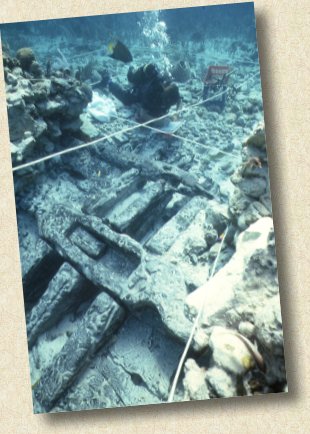 |
|
|
In the last two decades, Ships of Discovery’s research program has searched for, tested, and excavated several early European shipwreck sites in the Americas. Because no one site can answer all our questions about the ships, their contents, their crew and passengers, we traveled the Caribbean and beyond to examine various wrecks. Some sites offered signifcant artifacts, others contained well-preserved hull structure, still others tantilized us with the possibilities . . . |
| Molasses Reef Wreck Bahía Mujeres Wreck Highborn Cay Wreck Bahía Isabela Santa María Gallega |
 |
| The Bahía Mujeres wreck is the oldest European shipwreck found in Mexican waters. Sadly, a number of important artifacts were removed without the benefit of archaeological recording. The enthusiasts who removed the artifacts thought the wreck was Nicolasa, a ship in the fleet that helped conquer the Yucatán. However, that identification proved to be wrong when Ships of Discovery researchers determined that Nicolasa did not wreck. Most recently, we accompanied a team from Mexico's Instituto Nacional de Arqueología e Historia to examine the site. Previous cooperative expeditions had relocated and recorded some of the artifacts. |
Highborn Cay WreckThe similarity of artifact distribution to that of the Molasses Reef Wreck was remarkable, leading us to believe that information not available from the Molasses Reef wreck might be uncovered at this site. Encrusted wrought-iron breech-loading cannon, the anchors, and the few pieces of broken ceramics hint that the sunken vessel was Spanish from the first half of the 16th century. |
 |
For a shipwreck in the Caribbean, the Highborn Cay Wreck contained substantial wood remains. Because it was a discovery period shipwreck in the Western Hemisphere—therefore a ship that had made a least one transAtlantic voyage—its information was vital. The wreck provided construction details of the keel, keelson, mast step, stempost, framing, planking, notches for the bilge pumps, and floor–futtock joinery at midships. The overall length of the keel, obtained from its impression in the hardpan, allows an estimation of the length of a ship of the exploration and discovery period to be about 19 meters in length and 5.0–5.7 meters in beam. For the first time, such an estimation of a ship that forever joined the Old World to the New has been based on actual vessel remains instead of conjecture. |
Ships
| Exploration | Discovery
| Research | Our Mission
Headquarters | Exhibits |
Turks and Caicos Museum | About
Us | Our Network | Contributors
| Underwater Links
| Our Publications
Shipwreck Excavations | Columbus's
Lost Ships | Archival Documents | Conservation
| Ancient Techniques | Replicas
Experimental Archaeology